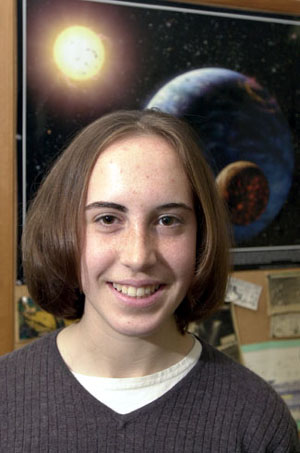The sky’s not the limit for this undergrad

Ann Marie Cody ’03 has long been reaching for the stars. As a high school student in Harvard, Mass., Cody was intrigued by the evidence detected by astrophysicists in 1995 that at least 30 Jupiter- and Saturn-like gaseous planets are orbiting distant stars.
“Not only have these discoveries provided spectacular confirmation that our solar system is not alone,” says Cody, “but they have also revolutionized current theories on the formation of planetary systems. One of the most surprising findings has been the counterintuitive observations that many of these massive new planets orbit extremely close to their parent stars.”
As a high school senior, Cody decided to pursue her interest in this expanding field. She began working with Dimitar Sasselov, Thomas D. Cabot Associate Professor of Astronomy, of the Harvard-Smithsonian Center for Astrophysics (CfA).
As a Harvard freshman, Cody heard about the Harvard College Research Program and applied to the program.
The research that Cody conducted during the spring of her freshman year allowed her to continue the work she had already begun, as well as update her research with current developments in the field. At that point, she explains, her “plans included researching the literature for data on the parent stars of extrasolar planets, with particular concentration on close-in planets.” Cody was able to identify the areas of orbital distance, planet mass, stellar rotation rate, and stellar metallicity, and study their relationships. She was also able to utilize codes on the Center for Astrophysics’ computers to determine mass, radius, and evolutionary tracks for parent stars of extrasolar planets. The results of this work would provide more information about the formation and evolution of extrasolar planet systems.
“As a side project,” says Cody, “I placed special focus on the star HD209458, which had been reported to display the first evidence of a planetary transit.” The data gathered would ultimately be used to make refinements on the radius of the star, “which would, in turn, reveal a wealth of information about the planet’s atmosphere and composition.”
By the end of her spring semester, Cody had both increased her knowledge of astrophysics as a topic in general, but also made great progress on her initial research topic. While she had gathered scientific information and assembled data profiles for several other stars, she was able to create computer models and plot evolutionary tracks for the star HD209458. In fact, she was nearly ready to produce a refined estimate of its radius.
It was now time, Cody says, to “take my studies further by honing calculations of HD209458’s properties and zeroing in on its possible age and radius ranges. These are two parameters not precisely known by the astronomical community, and they are essential to current research.”
Sasselov expected that during the summer months they would, as he puts it, “complete the computations, derive accurate physical parameters for HD209458, and prepare an article for publication. The field of extrasolar planets is as exciting as ever, and the focus of Ann Marie’s research is of immediate interest.”
Cody decided to apply for further funding from the Harvard College Research Program for the summer. The continued funding took the form of a stipend in order for her to conduct her research in the lab for a wage as opposed to having to look for a part-time job to cover her summer expenses. Conducting research on campus during the summer allowed Cody to work more closely with her faculty sponsor.
Sasselov, she says, “invited me to participate in research discussions with scientists and graduate students, and has also displayed some of my results and diagrams at a major symposium during the meeting of the International Astronomical Union in Europe. I was pleased to hear that no other extrasolar planet researchers are currently attempting the kind of computer-based analysis that we are using.”
Almost more important for the burgeoning scientist, Cody notes, are the intellectual and scholarly challenges her mentor sets for her: “to further hone my skills, Professor Sasselov has given me a great deal of encouragement to develop independence and scientific intuition in my work. While he is always ready to entertain my numerous questions, he often points me toward useful literature, rather than providing a quick, simple answer. I appreciate the high expectations that he places on me.”
For his part, Sasselov states that “during the past year, Ann Marie has accomplished a lot. I dare say that what she has accomplished is comparable to work done even by some of our graduate students. Her project is both fundamental and exciting, and some of my colleagues are already starting to pay attention to her work. Ann Marie and I have written a paper, which is on my desk and ready to be submitted to the professional journal with highest standards, The Astrophysical Journal. Ann Marie did the major part of the work and of the writing of the paper, and is deservedly the first author.”
This fall, Cody proposed to research a much broader context of extrasolar planet systems. “Recently, it has been hypothesized that planets in unstable orbits may migrate inward and eventually fall into their parent star’s atmosphere. This process would lead to a significant increase in the heavy metal content in the uppermost layers of the star. I plan to attack the problem by examining the metallicities of a considerable sample of these stars and exploring the effects of high- and low-metal atmospheres using my computer-modeling skills. I hope to determine whether metal ‘pollution’ has an observable effect, and how strong the current evidence is for planetary migration.”
An ambitious project, but if anyone can do it . . .
Christy McKellips




